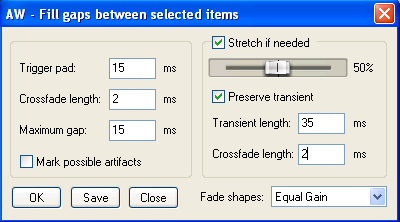AW - Fill gaps
From CockosWiki
Contents |
About
"AW - Fill gaps between selected items" is created by Adam Wathan and is part of the SWS extension. Usually used as last step in quantizing audio.
How to get there
Install the SWS extension
- Extensions > Fill gaps..
Settings
Trigger Pad
This is a leading pad added to the beginning of each chunk and subtracted from the end of the previous chunk. The snap offset is adjusted to compensate so that your media will still snap to the transient. It is a sort of safety buffer. Imagine you have a section where the snare and ride hits at the same time, but the ride is a tiny bit early. Dynamic split cut at the snare transient though for one of a variety of reasons. This buffer would ensure that the ride transient is preserved directly before the snare and that it is cut out of the previous item. It basically just lets you be lazier when checking the quality of your splits
Crossfade Length
This is the length of the crossfade created between the tail of any item and the beginning of the next item. It is always placed to the left and is in addition to any trigger pad (ie. a trigger pad of 5ms and a crossfade length of 5ms will result in a minimum of 10ms between the start of the crossfade and the transient in the next item.)
Maximum Gap
This is the maximum allowable gap before the code attempts to time stretch the previous item. If you set a max gap of 20ms and the code detects a gap of 50ms, it will timestretch the previous item until either a) the gap has been reduced to 20ms, or b) the Maximum Stretch value has been reached. If the detected gap is less than the Maximum Gap, the following item is simply trimmed back to fill it with no stretching applied whatsoever.
Maximum Stretch
This is the maximum amount that an item will stretch. The value corresponds with the "Rate" value displayed in a media item when timestretching it, so 0.85 means the item will stretch to a maximum rate of 0.85 In my experience, it usually sounds better to allow more stretching than it does to allow a larger Maximum Gap, so don't be afraid to set this value low. A value of 0 will let the item stretch as much as it needs to while a value of 1 will disable stretching entirely.
Preserve Transient
This is the amount of the item you want to prevent from stretching no matter what. Stretching the initial attack of a media item usually sounds poor, so this will prevent that initial attack from stretching and only stretch the tail of the item. If this is set to 35ms for example, a split is placed 35ms after the transient and only the item to the right of the split will be stretched, leaving the initial attack untouched. A value of 0 disables this function completely. The default value of 35ms is usually pretty good.
Transient Crossfade Length
This is simply the length of the crossfade used when splitting at the "Preserve Transient" point.
Fade Shape
This determines the shape of the fades used when performing any crossfades. It is an integer from 0 to 5, the following chart explains which is which.
Mark possible artifacts?
This is a value of 0 (no) or 1 (yes). If 1 is entered, the action will insert a marker everywhere that the gap exceeded the maximum allowable gap AND the maximum stretch value was reached, which means it had to trim the start of the following item more than expected. This allows you to easily identify areas where there might be an audible glitch so you can listen to them with special attention and either time stretch more to fix it, or copy and paste a better hit from a different part of the song.
